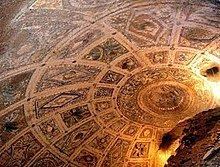Discovery January 2007 | Depth 15m | |
 | ||
Lupercalia
The Lupercal (from lupa, Latin for she-wolf) is a cave at the foot of the south side of Palatine Hill in Rome, between the Temple of Apollo Palatinus and the Basilica di Sant'Anastasia al Palatino. In the legend of Rome's foundation, Romulus and Remus were found there by a she-wolf who suckled them until they were rescued by the shepherd Faustulus. The priests of Lupercus later celebrated certain ceremonies of the Lupercalia there, from the earliest days of the City until AD 494, when the practice was ended by Pope Gelasius I.
Contents
Vaults of terra horus heresy horus lupercal
Modern discovery
In January 2007, Italian archaeologist Irene Iacopi announced that she had probably found the legendary cave beneath the remains of Emperor Augustus's house, the Domus Livia, on the Palatine. Archaeologists came across the 15-meter-deep cavity while working to restore the decaying palace.
On 20 November 2007, the first set of photos were released showing the vault of the cave which is encrusted with colourful mosaics, pumice stones and seashells. The center of the ceiling features a depiction of a white eagle, the symbol of the Roman Empire during the reign of Augustus, the first Roman emperor. Archaeologists are still searching for the entrance of the grotto.
Its location below Augustus' residence is thought to be significant; Octavian, before he became Augustus, had considered taking the name Romulus to indicate that he intended to found Rome anew.
Opposing opinions
Adriano La Regina (formerly Rome’s archaeological superintendent 1976-2004, professor of Etruscology at Rome’s La Sapienza University), Professor Fausto Zevi (professor of Roman Archaeology at Rome's La Sapienza University) and Professor Henner von Hesberg (head of the German Archaeological Institute, Rome) denied the identification of the grotto with Lupercal on topographic and stylistic grounds. They concluded that the grotto is actually a nymphaeum or underground triclinium from Neronian times.
